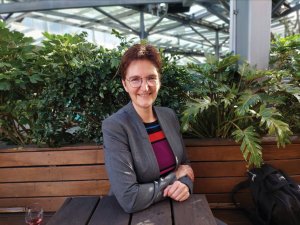Respiratory physician Lutz Beckert considers chronic obstructive pulmonary disease management, including the prevention of COPD, the importance of smoking cessation and pulmonary rehabilitation, and the lifesaving potential of addressing treatable traits. He also discusses the logic of inhaler therapy, moving from single therapy to dual and triple therapy when indicated, as well as other aspects of management
Locality formation to become more standardised to avoid 'chaos'
Locality formation to become more standardised to avoid 'chaos'
![Jeff Lowe [Image: supplied]](/sites/default/files/styles/cropped_image_16_7_/public/2022-06/Jeff%20Lowe.jpg?itok=qEeoyQdu)
“It’s been so free flowing that the sorts of organisations that are participating in locality discussions vary a lot and the kind of way they want to structure their activities varies a lot”
Te Whatu Ora is writing a “localities guidebook” to bring more consistency to this formalised layer of primary and community care gradually being ushered in by the Government’s health reforms.
Twelve localities have been established, of the 60 to 80 anticipated by mid-2024 when all parts of the country must be in a locality.
Te Whatu Ora chair Rob Campbell said after yesterday’s joint meeting with the Te Aka Whai Ora board there has been great freedom to date in the formation of localities, but that has come with a lack of understanding of the expectations of localities.
“…it’s been so free flowing that the sorts of organisations that are participating in locality discussions vary a lot and the kind of way they want to structure their activities varies a lot,” Mr Campbell said, answering New Zealand Doctor Rata Aotearoa at an online media briefing.
“We want [localities] to be free to drive what their community wants in terms of health outcomes but we do need to provide some consistency in terms of the areas they cover, who's involved and how they conduct themselves and how they report.
“Otherwise it would just be chaos.”
Mr Campbell says a great deal about locality formation has been learnt from the nine prototype localities unveiled in April. But the need now is to move to a much more organised type of locality creation.
“It’s reasonably imminent, the production of a localities guidebook which will create some better frameworks for people to use. That will precede the announcement of any new [localities].”
BILLBOARD
Antimicrobial stewardship: It's time for collective action
FREE WEBINAR: Tuesday 22 November, 7pm-8pm
Speakers, Dr Sharon Gardiner and associate professor Matire Harwood discuss the recommendations,of the report Kotahitanga: Uniting Aotearoa against infectious disease and antimicrobial resistance, and what they mean for primary care and Māori
+This is a World Antimicrobial Awareness Week activity+
Click here for details and to register
Asked how many iwi-Māori partnership boards have been established and their locations, Te Aka Whai Ora chair Tipa Mahuta told the briefing 11 are going through the parliamentary process.
Eighteen iwi-Māori partnership boards were listed in the Pae Ora (Healthy Futures) Bill, but their names were deleted by the committee of MPs that considered the bill. The committee’s process for establishing the boards was adopted in the Pae Ora (Healthy Futures) Act 2022. It involves the Crown establishing boards by order in council after a potential board has notified Te Aka Whai Ora, and the agency is satisfied the act’s rules have been met.
Te Aka Whai Ora chief executive Riana Manuel told the 1 July meeting of the agency there were 10 boards under way, according to the meeting’s minutes.
In her update yesterday, Ms Mahuta said most of the 11 current boards are in the North Island. She undertook to provide their actual locations later.
Following media pressure over openness since the two new health agencies came into being on 1 July, yesterday’s joint boards’ meeting marked the first time reporters were allowed to attend either board meeting. Although it was a matter of choice by the boards, it harked back to the former DHBs’ board meetings which were, by law, open to the public and media, apart from specific sections that were conducted behind closed doors.
The open section of yesterday’s meeting was the last hour, in which members were asked to talk about the challenges they see in the health reforms, the changes they think are needed and their vision for healthcare in New Zealand.
New Te Whatu Ora board member and specialist GP Jeff Lowe, the sole GP on the board, talked of “demonstrating the art of the possible”.
“I believe we have fantastic innovation in New Zealand already and most of it happens organically. The issue is that that innovation is not always available to everybody in New Zealand. So it matters where you live and who you are as to what services are delivered.
“Our challenge is to take good innovation and move it at scale and pace and make it available to everybody in New Zealand.”
A member of Te Whatu Ora’s Planned Care Taskforce, he says there is an important opportunity in planned care and the need to “reset” the system.
The question should be asked: where are services best delivered?
“Does it need to be delivered in a hospital? If it doesn’t, we should be looking to get it out to the community where people work live and play and make it more accessible.”
We're publishing this article as a FREE READ so it is FREE to read and EASY to share more widely. Please support us and the hard work of our journalists by clicking here and subscribing to our publication and website







![Barbara Fountain, editor of New Zealand Doctor Rata Aotearoa, and Paul Hutchison, GP and senior medical clinician at Tāmaki Health [Image: Simon Maude]](/sites/default/files/styles/thumbnail_cropped_100/public/2025-03/Barbara%20Fountain%2C%20editor%20of%20New%20Zealand%20Doctor%20Rata%20Aotearoa%2C%20and%20Paul%20Hutchison%2C%20GP%20and%20senior%20medical%20clinician%20at%20T%C4%81maki%20Health%20CR%20Simon%20Maude.jpg?itok=-HbQ1EYA)
![Lori Peters, NP and advanced health improvement practitioner at Mahitahi Hauora, and Jasper Nacilla, NP at The Terrace Medical Centre in Wellington [Image: Simon Maude]](/sites/default/files/styles/thumbnail_cropped_100/public/2025-03/2.%20Lori%20Peters%2C%20NP%20and%20advanced%20HIP%20at%20Mahitahi%20Hauora%2C%20and%20Jasper%20Nacilla%2C%20NP%20at%20The%20Terrace%20Medical%20Centre%20in%20Wellington%20CR%20Simon%20Maude.jpg?itok=sUfbsSF1)
![Ministry of Social Development health and disability coordinator Liz Williams, regional health advisors Mary Mojel and Larah Takarangi, and health and disability coordinators Rebecca Staunton and Myint Than Htut [Image: Simon Maude]](/sites/default/files/styles/thumbnail_cropped_100/public/2025-03/3.%20Ministry%20of%20Social%20Development%27s%20Liz%20Williams%2C%20Mary%20Mojel%2C%20Larah%20Takarangi%2C%20Rebecca%20Staunton%20and%20Myint%20Than%20Htut%20CR%20Simon%20Maude.jpg?itok=9ceOujzC)
![Locum GP Helen Fisher, with Te Kuiti Medical Centre NP Bridget Woodney [Image: Simon Maude]](/sites/default/files/styles/thumbnail_cropped_100/public/2025-03/4.%20Locum%20GP%20Helen%20Fisher%2C%20with%20Te%20Kuiti%20Medical%20Centre%20NP%20Bridget%20Woodney%20CR%20Simon%20Maude.jpg?itok=TJeODetm)
![Ruby Faulkner, GPEP2, with David Small, GPEP3 from The Doctors Greenmeadows in Napier [Image: Simon Maude]](/sites/default/files/styles/thumbnail_cropped_100/public/2025-03/5.%20Ruby%20Faulkner%2C%20GPEP2%2C%20with%20David%20Small%2C%20GPEP3%20from%20The%20Doctors%20Greenmeadows%20in%20Napier%20CR%20Simon%20Maude.jpg?itok=B0u4wsIs)
![Rochelle Langton and Libby Thomas, marketing advisors at the Medical Protection Society [Image: Simon Maude]](/sites/default/files/styles/thumbnail_cropped_100/public/2025-03/6.%20Rochelle%20Langton%20and%20Libby%20Thomas%2C%20marketing%20advisors%20at%20the%20Medical%20Protection%20Society%20CR%20Simon%20Maude.jpg?itok=r52_Cf74)
![Specialist GP Lucy Gibberd, medical advisor at MPS, and Zara Bolam, urgent-care specialist at The Nest Health Centre in Inglewood [Image: Simon Maude]](/sites/default/files/styles/thumbnail_cropped_100/public/2025-03/7.%20Specialist%20GP%20Lucy%20Gibberd%2C%20medical%20advisor%20at%20MPS%2C%20and%20Zara%20Bolam%2C%20urgent-care%20specialist%20at%20The%20Nest%20Health%20Centre%20in%20Inglewood%20CR%20Simon%20Maude.jpg?itok=z8eVoBU3)
![Olivia Blackmore and Trudee Sharp, NPs at Gore Health Centre, and Gaylene Hastie, NP at Queenstown Medical Centre [Image: Simon Maude]](/sites/default/files/styles/thumbnail_cropped_100/public/2025-03/8.%20Olivia%20Blackmore%20and%20Trudee%20Sharp%2C%20NPs%20at%20Gore%20Health%20Centre%2C%20and%20Gaylene%20Hastie%2C%20NP%20at%20Queenstown%20Medical%20Centre%20CR%20Simon%20Maude.jpg?itok=Z6u9d0XH)
![Mary Toloa, specialist GP at Porirua and Union Community Health Service in Wellington, Mara Coler, clinical pharmacist at Tū Ora Compass Health, and Bhavna Mistry, specialist GP at Porirua and Union Community Health Service [Image: Simon Maude]](/sites/default/files/styles/thumbnail_cropped_100/public/2025-03/9.%20Mary%20Toloa%2C%20Porirua%20and%20Union%20Community%20Health%20Service%20in%20Wellington%2C%20Mara%20Coler%2C%20T%C5%AB%20Ora%20Compass%20Health%2C%20and%20Bhavna%20Mistry%2C%20PUCHS%20CR%20Simon%20Maude.jpg?itok=kpChr0cc)